
With rumors flying about the Winnipeg Jets Patrik Laine, should Bob Murray and the Anaheim Ducks dip their webbed feet into the waters?
There has been a lot of chatter about the Winnipeg Jets needing to deal one of its big names to acquire help to become a more well-rounded team, in order to compete for the Stanely Cup. like most fans of most teams, Anaheim Ducks fans have been seemingly catering about acquiring Patrik Laine.
Why wouldn’t they? He’s a young stud-muffin. Anyway, it only seems right that I should break down my own thoughts on the chances of that happening, and answer the question, “will Patrik Laine become a Duck?”
The shorts answer, for you speed readers in a hurry is this…
No.
The long answer to that question is…
Nnnnoooooooooooo
But, I guess if you’re reading one of my articles it is because you want to read thousands upon thousands of words that you probably don’t agree with. So the really, really long answer is as follows.
Why Would The Winnipeg Jets Do It?
It’s a little hard to fathom why the Winnipeg franchise would wait for 10-years to acquire players like Laine (and Nikolaj Ehlers), develop them into their prime scoring ages, and then move them to commence another rebuild. It’s even harder to fathom why they would assume Laine has peaked at 22-years-old and after his most arguably “complete” season as a hockey player.
Certainly, if you’re a big believer in aging curves and expect that 22-years-old is a peak of sorts, then it might maybe make sense to move a player prior to his next big payday. Let’s not beat about the bush, Laine’s next contract will likely be a monster one.
Nonetheless, moneypuck is suggesting that Laine’s ability to shoot the puck is nearly 30% above the average NHL player. That gives him a long way to fall even if he has peaked at 22.
There’s absolutely no doubt that Laine is an elite scorer of goals. The list of players who have recorded back-to-back 20-goal seasons in the NHL is a very short list. Names include Sidney Crosby, Jaromir Jagr, Steven Stamkos, and, of course, Patrik Laine.
I don’t think it’s out of the question to suggest that Laine will, at least once in his career, post up a 50-goal season. It could be due to an increase in ice time, and an increase in shot rates, or merely a luck season in which a higher number of shots find the back of the net. Nonetheless, I strongly believe it will happen.
However, while Laine possesses frightening offensive weapons, he does have some flaws to his game. Some of which even raise their heads when discussing Laine’s primary role as a shooter. Notably, he’s a somewhat overrated stick-handler which can run him into trouble on occasion. In this past season, Laine ranked 2nd amongst Jet’s forwards for giveaways in what was a season he turned over a career-high number of pucks.
Given this somewhat wonky ability to hold the puck, it’s hard to present Laine as a “two-way” player. This becomes even more evident when consideration is given to Laine’s steadily increasing offensive zone (OZ) starts. Laine was brought into the league as a somewhat sheltered scoring forward (rightly so), given ~58.7% of his starts in the OZ. However four years into his career, he has seen a steady increase in OZ starts each season, culminating in ~65.1% of his starts commencing there this past season.
In line with the increase in OZ starts, Laine has also presented an increasing trend regarding expected goals against. Both scoring chances against, and high danger scoring chances against, have trended up over Laine’s career. The 2019-2020 season saw the Jets give up ~3.7 high danger Corsi attempts per game (even strength), while Laine was on the ice.
While the Jets game up the most attempts of this sort of any team in the league last season (~10.6 per game at even strength), it’s hard to argue that ~35% of them coming while a single player is on the ice, is a good look. This despite it being a front line player earning the 3rd most minutes per game amongst the forwards.
Teams looking for more defensive pressure from their forward group may do well to move in a different direction. Which may be where the Jets find themselves at present. The last 12-months have seen the Jets blue line gutted from what was a reasonably strong group of players. Jacob Trouba and Dustin Byfuglien headline the names of the players who have left the Jets defensive unit over that time period.
There is no doubt that these losses have had a direct impact on the Jets as a whole, and the sharp spike in defensive numbers presented by players such as Laine, however, it is also true that Laine has been trending down across these metrics for the past few years. Nonetheless, the Jets need to stabilize their defensive end if they expect to make noise in the postseason.
In order to strengthen the team defensively, the Jets can either look to play a greater “team” defense, in which the forwards contribute significantly to the overall structure, or they can look for help on the blue line. Most good teams will do both.
Thus with young guns, Kyle Connor and Ehlers, still under 25-years old and signed long term, it may be Laine who is moved for a strong 2nd line pivot with a strong defensive acumen, or for upgrades on the blue line. Given the age of the Jet’s best players, they could consider that they have some time with their cup window open, thus help can be both immediate and in the near future.
